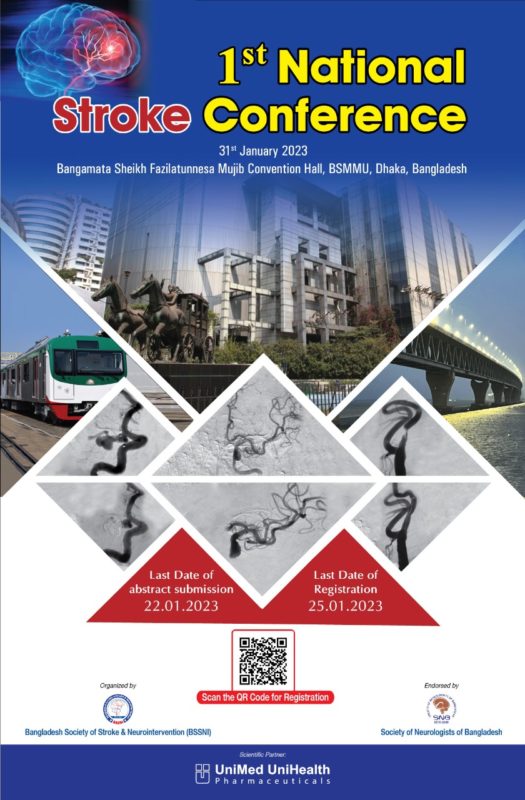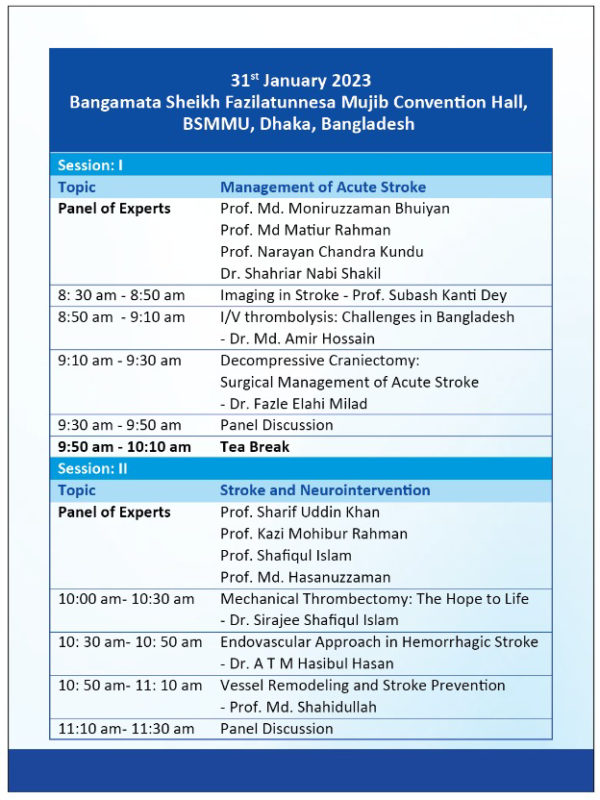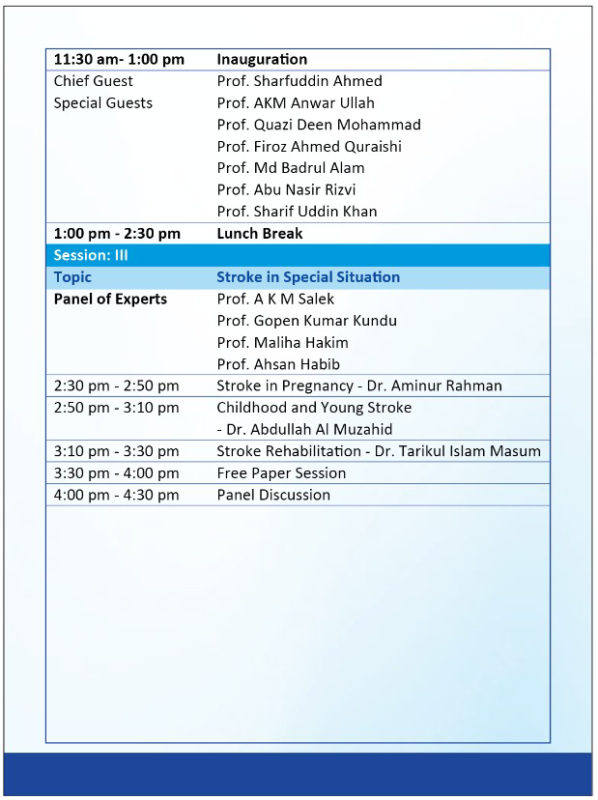Dear Colleagues and Friends,
A warm wish to all of you in 2023 and a Happy new year. Bangladesh Society of Stroke and Neurointervention (BSSNI) is very happy to announce the 1st National Stroke Conference to be held on 31st January 2023 at Bangamata Sheikh Fazilatunnesa Mujib Convention Hall, BSMMU, Dhaka. With your active participation, our last event The 1st Dhaka Course on Neurointervention had been an enormous success in 2020. Unfortunately, we could not meet in person after that due to the COVID pandemic. Although we had arranged several online seminars, this is the high time for us to meet face to face again to share the recent advances in exciting field of Stroke treatment. We will focus on evidence based stroke management. This will be an excellent opportunity for the post graduate students to learn about the advances in stroke medicine. Special attraction will be stroke management in special situation. We welcome all the physicians and surgeons related to stroke management, including pediatricians and obstetricians to join this wonderful event. It will be an exciting platform for sharing knowledge and experience. We hope to welcome you all in the newly constructed convention hall. Please note the date and venue in your calendar.
Date: 31st January, 2023 (Tuesday)
Time: 8:00 am
Venue: Bangamata Sheikh Fazilatunnesa Mujib Convention Hall, BSMMU, Dhhaka
Registration Fees: Post Graduate Students – TK 500 , Medical Officer and above – TK 1000
Last date for Abstract submission: 22.01.2023
Last Date for Registration: 25.01.2023
For any registration related queries please contact, Dr. A T M Hasibul Hasan, room 415, National Institute of Neurosciences and Hospital or Dr. Abdullah Al Muzahid, room-1314, Department of Neurology, BSMMU.
Deadline: 20.01.2023
Submission Guideline:
Before submitting your abstract, thank you for paying attention to the following guidelines:
- You must complete the registration process before submitting the abstract.
- You will be able to submit abstracts in each topic, but a maximum of 1 abstract per topic is allowed.
- You will be able to submit abstract online and you will get a confirmation email of submission.
- Abstract will be within 250 words
- Best three abstract will be awarded and accepted for free paper session.
- One abstract will be awarded from the free paper presentation.
- No abstract can be submitted after the dead line.
Oral presentation of Free Papers are expected to have very high scientific quality and should
correspond to complete studies with outstanding results and innovative conclusions.
The work needs to be scheduled for 5 minutes of presentation (maximum 10 slides).
Speakers must adhere strictly to the scheduled times according to the program.
The presenter will be provided with an LED screen
Only computer projection will be available.
It will be possible to use personal laptops.
Speakers are kindly requested to use PowerPoint MS Office (Windows or Mac).
Presentations prepared with Keynote and Prezi can also be accepted but additional
technical support might be required on-site.
We recommend using “.gif” and “.jpg” formats for images. Other types of extension
are accepted but prior advice from our technical team on-site is required.
MPEG2 is the preferred format for embedded videos, but *.avi, *.wmv are also
accepted.
Confirm that all the necessary files are in the SAME FOLDER as your presentation.
Use large fonts (the minimum font size should be 18 points). If you cannot fit all your
subjects on a slide without moving to a smaller font, break the points up onto separate
slides.
Confirm that your presentation contains only standard fonts. For cross-platform
compatibility, the use of Times New Roman, Arial, Verdana is advised. Some other fonts
may not transfer properly from your computer to the system used for presentation.
Limit each slide to one main idea with three to six points. If more than six points (bullets)
are included in one slide, your audience will have difficulties to read it. We recommend 5
to 7 slides for a five-minute free paper.
The use of USB pens or memory sticks is advisable to upload presentations easily at the
Centre.
Enclosure of a disclaimer at the bottom of the ending slide (Acknowledgment,
Summary, or Question & Answer Session slide) is recommended.
General instructions for your poster
Poster size should be A0 portrait oriented (width: 84.1cm / 33.1 inch,
Length:118.9cm / 46.8 inch). Do not exceed these dimensions.
Apply the KISS principle: ‘Keep it Short and Simple’. Avoid putting too much
text and figures on the poster.
Your poster is a visual aid to present your work. The less text the better. Visual
elements such as figures, graphs, diagrams should dominate.
Use a light colour background and dark colour letters for contrast. Use 2-3 colours
and avoid overly bright colours.
Presenting your poster: Prepare a poster pitch of three minutes at the very most, in
which you walk your audience through the most important results of your poster.
Practice your poster pitch beforehand. Only provide more information to those
who ask, remember, most attendees would like to visit as many posters as
possible.
Include a photo of yourself and your contact information, so that people can reach
out to you if they look at your poster when you are not there.
Font size & type
The poster must be easily readable from 2 m distance
The title should be at least 100 pt, font size the text on the poster at least 36 pt.
Don’t mix fonts, chose one font for all text blocs in the entire poster. You may
wish to use a second font for title + headings and figures and tables.
Text elements
Use text sparingly. Your poster is not a paper, and there is little time for visitors to
read. Let the visuals speak.
Use columns of max. 70 characters (including spaces) width. Avoid large blocks
with text and long sentences (<10 sentences per block; <50 words per block).
Avoid large blocks of text. Instead, use bulleted statements.
Avoid abbreviations. When abbreviations or codes are necessary, keep them as
simple as possible.
Choose the line spacing such that the use of sub- and superscripts will not affect
the layout of text blocks.
Poster design
Your title is 90% of your poster. It's the first thing the audience reads. If your title
is long and complicated, most will assume the rest of your poster is as well.
Place your most important information on the top or middle of the poster, not on
the bottom where most people cannot easily read it.
The objectives of the study, the research questions or the hypothesis should be
clearly stated in as few words as possible.
As a rule, methods should be as short and general as possible.
Results should be presented preferably as figures, graphs, etc.. They should be
self-explanatory and include a legend. Providing an interpretation of the results
below each image helps the reader understand what the 'take home message' of
the image is.
The conclusions should be succinctly stated on large type font. Many viewers
read the conclusions first, and read only your conclusions. Hence the main
conclusions should be easy to locate and easy to understand. Indicate in the
conclusions:
o
do your findings confirm your hypothesis?
the novelty your findings
their relevance beyond your study
Figures and Graphs
An image says 1000 words. Let your images do the talking, not the text.
• Graphs or tables should be self-explanatory and include a well-worded, concise
legend. Symbols are best explained in an inset within the figure or graph, so the
reader doesn't have to jump back and forth between the legend and the image.
Put legends above a table and below a figure.
Keep legends short (10-25 words).
Figures
Properly label the x- and y-axis of graphs, include units.
Keep graphs as simple as possible.
Include the results of statistical analyses (significance levels) in the graphs by
using discriminating letter codes (a, ab, b) or asterisks (*, **, ***).
Tables
Do not use tables that contain more than 20 items. Complex data should not be
included in your poster but may be provided in a separate information sheet.
Do not give more decimals than necessary to show meaningful variation.



